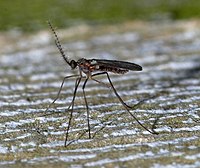
Photo from wikipedia
Anopheline larvae rely on their antennae to respond to a complex suite of stimuli with which they navigate their aquatic environment, search for food, and avoid predators and pollution. Chemosensory… Click to show full abstract
Anopheline larvae rely on their antennae to respond to a complex suite of stimuli with which they navigate their aquatic environment, search for food, and avoid predators and pollution. Chemosensory signaling initiates on dendrites innervating the sensory peg and sensory cone, which are adjacently located at the distal (apical) end of the larval antennae. These structures are the primary sites for the detection of both soluble and volatile semiochemicals, which are biologically relevant chemical signals (typically unitary or blends of compounds) released by one organism that affect the behavior of another. The sensory neurons housed in the larval antennal sensory cone are responsible for the signal transduction processes that initiate responses to a range of volatile stimuli. To investigate the mosquito larval olfactory neuronal response to volatile odorants, we developed this method to record, extracellularly, the electrophysiological responses of sensory cone neurons to a range of chemical stimuli. This method provides an in vivo demonstration of how mosquito larvae perceive volatile semiochemicals in their environment.
Journal Title: Cold Spring Harbor protocols
Year Published: 2022
Link to full text (if available)
Share on Social Media: Sign Up to like & get
recommendations!